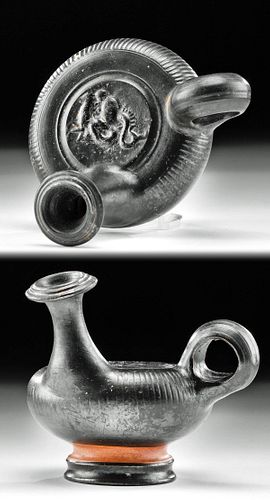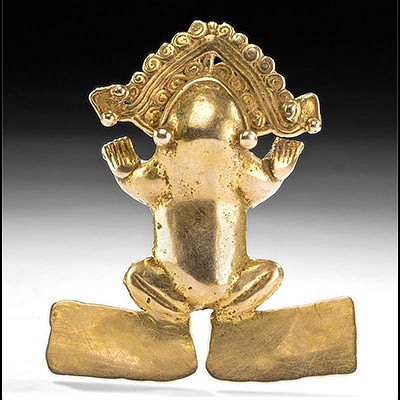Greek Apulian Pottery Guttus with Nereid on Hippocamp
Lot 17a
About Seller
Artemis Fine Arts
686 S Taylor Ave, Ste 106
Louisville, CO 80027
United States
Selling antiquities, ancient and ethnographic art online since 1993, Artemis Gallery specializes in Classical Antiquities (Egyptian, Greek, Roman, Near Eastern), Asian, Pre-Columbian, African / Tribal / Oceanographic art. Our extensive inventory includes pottery, stone, metal, wood, glass and textil...Read more
Categories
Estimate:
$900 - $1,200
Absentee vs Live bid
Two ways to bid:
- Leave a max absentee bid and the platform will bid on your behalf up to your maximum bid during the live auction.
- Bid live during the auction and your bids will be submitted real-time to the auctioneer.
Bid Increments
| Price | Bid Increment |
|---|---|
| $0 | $25 |
| $300 | $50 |
| $1,000 | $100 |
| $2,000 | $250 |
| $5,000 | $500 |
| $10,000 | $1,000 |
| $20,000 | $2,500 |
| $50,000 | $5,000 |
| $100,000 | $10,000 |
| $200,000 | $20,000 |
About Auction
By Artemis Fine Arts
Aug 13, 2020
Set Reminder
2020-08-13 10:00:00
2020-08-13 10:00:00
America/New_York
Bidsquare
Bidsquare : Fine Antiquities, Ethnographic & Fine Art
https://www.bidsquare.com/auctions/artemis-gallery/fine-antiquities-ethnographic-fine-art-5415
Features classical antiquities, ancient and ethnographic art from cultures encompassing the globe. Egyptian, Greek, Roman, Etruscan, Near Eastern, Asian, Pre-Columbian, Native American, African / Tribal, Oceanic, Spanish Colonial, Russian, Fine Art, so much more! Artemis Fine Arts info@artemisfinearts.com
Features classical antiquities, ancient and ethnographic art from cultures encompassing the globe. Egyptian, Greek, Roman, Etruscan, Near Eastern, Asian, Pre-Columbian, Native American, African / Tribal, Oceanic, Spanish Colonial, Russian, Fine Art, so much more! Artemis Fine Arts info@artemisfinearts.com
- Lot Description
Magna Graecia, Apulian, ca. 350 to 300 BCE. A black glazed pottery guttus with an elegant fluted body on a high foot, a ring handle, a central spout with a rounded rim moulding, and in relief on the top a medallion depicting a Nereid riding a hippocamp (a prancing horse with a fish tail). The Nereid holds an oval shield covering her left arm and shoulder. This imagery stems from the cortege of Nereids that carried Achilles arms. The Nereids were sea nymphs oftentimes depicted riding dolphins or aquatic snakes known as ketoi. A wonderful example, replete with impressive artistry and intriguing iconography. Size: 4.25" W x 3.75" H (10.8 cm x 9.5 cm)
A guttus was a vessel used to store precious oil to fill oil lamps. The name guttus implies that the oil was to be released drop by drop. This was made possible by the tiered, molded rim and the elongated spout which prevented air from entering too quickly and easily.
See a related guttus in the Museo Nazionale of Naples (inv. No. 665 (302), cf. fig. 140 and pp. 285-286 in: Marie-Odile Jentel. Les Gutti et les Askoi a Reliefs Etrusques et Apuliens. Leiden 1976.
See another Apulian guttus featuring similar iconography at the British Museum (accession number 1836,0224.392).
Provenance: private Dere collection, New Jersey, USA, acquired from Ostracon Gallery, Switzerland (accompanied by COA from Dr. Bernhard I. Muller, Ostracon Gallery, Switzerland): ex collection Rab, Zurich,Switzerland. Thence Schuyler Auktionen Zurich, December 2007 sale, lot no. 6982
All items legal to buy/sell under U.S. Statute covering cultural patrimony Code 2600, CHAPTER 14, and are guaranteed to be as described or your money back.
A Certificate of Authenticity will accompany all winning bids.
We ship worldwide and handle all shipping in-house for your convenience.
#157247A 1/4" by 1" section of rim restored (only visible from beneath the rim) else intact and excellent.Condition
- Shipping Info
-
All shipping is handled in-house for your convenience. Your invoice from Artemis Gallery will include shipping calculation instructions. If in doubt, please inquire BEFORE bidding for estimated shipping costs for individual items.
-
- Buyer's Premium



 EUR
EUR CAD
CAD AUD
AUD GBP
GBP MXN
MXN HKD
HKD CNY
CNY MYR
MYR SEK
SEK SGD
SGD CHF
CHF THB
THB

















